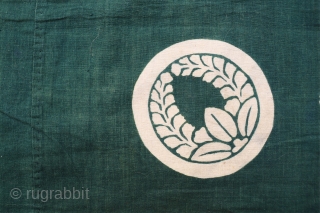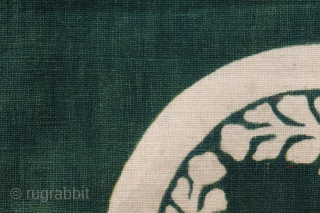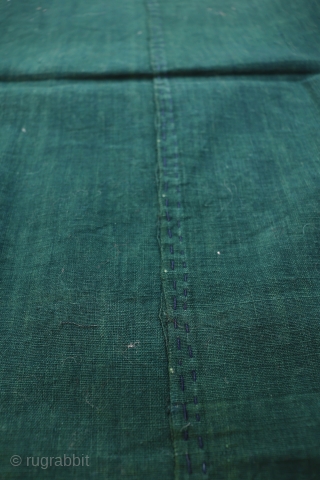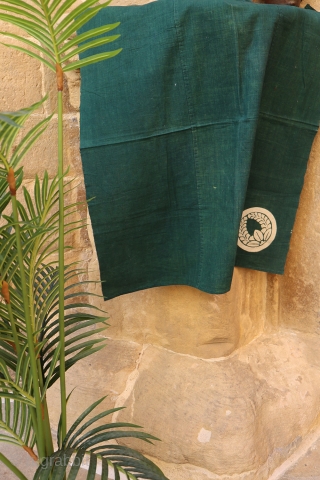Back
This antique Furoshiki is dyed with indigo blue. The techique used for the motif is the Tsutsugaki and the motif is an emblem.
Furoshiki (風呂敷?) is a traditional Japanese square cloth used to wrap and transport all kinds of objects, from clothing and gifts to glass bottles.
It began to be used in the Muromachi period (1392-1573), in traditional Japanese baths (onsen), so as not to confuse or mix the clothes. In this way, they used the furoshiki and left the clothing on it. Over time its use spread and it began to be used by merchants to protect their merchandise or gifts.
Tsutsugaki (筒描) is a Japanese reserve dyeing technique . The technique consists of drawing designs on cloth using rice paste, dyeing the cloth, and finally rinsing to remove the paste. 1
Rice paste is usually made from sweet rice, which has a high starch content and is therefore relatively sticky. The paste is applied using a sleeve (the tsutsu ) which is similar to the sleeves used by pastry chefs to decorate cakes. Another modality consists of applying the paste using a stencil ; called katazome . 2
Usually the fabric is cotton , and the dye is indigo , so the design is usually blue and white. Business signs and other signs are often made in this way.
Often the designs are creatures from Japanese mythology such as cranes or turtles , or a family crest, or a name (written in kanji ). Designs showing flowers and trees are also sometimes used.
This antique Furoshiki is dyed with indigo blue. The techique used for the motif is the Tsutsugaki and the motif is an emblem.
Material: Cotton
Size: 97×96 cms
Origin: Japan
You can buy this bargain furoshiki directly from our web: https://www.nomada.biz/en/producto/antique-cloth-from-japan-97x96-cms/
price:
Bargain: 75 Euros
- Home
- Antique Rugs by Region
- Category
- Profiles
- Post Items Free
- Albums
- Benaki Museum of Islamic Art
- Budapest: Ottoman Carpets
- Gulbenkian Museum
- Islamic Carpets. Brooklyn
- Islamic Textiles. Brooklyn
- Konya Museum: Rugs
- MKG, Hamburg
- MMA: Caucasian Carpets
- MMA: Mamluk Carpets
- MMA: Mughal Indian Carpets
- MMA: Ottoman Carpets
- MMA: Safavid Persian Carpets
- MMA: Turkmen Rugs
- McCoy Jones Kilims
- Ottoman textiles. Met
- Philadelphia Museum
- Rugs and Carpets: Berlin
- Seljuqs at the Met
- TIEM, Istanbul: Carpets
- V&A: Classical Carpets
- Vakiflar Carpets: Istanbul
- Baluch Rugs: Indianapolis
- Gallery Exhibitions
- Jaf an Exhibition
- Alberto Levi Gallery
- Andean Textile
- Christie's London: 2016
- Francesca Galloway
- HALI at 40
- ICOC Washington, DC 2018
- Jajims of the Shahsavan
- London Islamic Week April, 2018
- Mongolian Felts
- Navajo Rugs: JB Moore
- Persian Piled Weavings
- SF Tribal & Textile Art Show 2020
- SF Tribal 2019
- Sotheby's: C. Alexander
- Turkish Prayer Rugs
- Turkmen Main Carpets ICOC 2007











